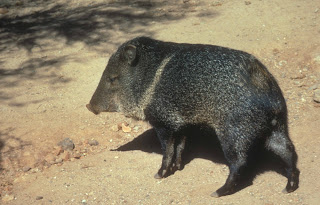Also called Javelina because of their razor-sharp tusks, it is Spanish for javelin or spear.
In Texas, Collared Peccaries live in the brushy semi-desert where prickly pear is a conspicuous part of the flora. They have poor eyesight but good hearing. They travel in small herds or "family groups" from six to twelve, although as many as 50 have been seen together, and seem to have a somewhat limited home range. In the winter, they are generally active in the early morning and late afternoon. Javelina are largely nocturnal during the hotter times of the year. They feed primarily on cacti (particularly prickly pear), mesquite beans, lechuguilla, sotol, nuts, fruits, and insects. In areas where prickly pear is abundant, peccaries seldom frequent water holes because these plants provide both food and water.
Incorrect tales of the peccary have caused hunters to kill them because of fear rather than for either sport or food. Through the exaggerated stories of the peccary’s ferociousness, it has been charged that peccaries will kill or injure dogs, and that they are a menace to deer hunters in the dense brush. It is true that encounters between peccaries and untrained dogs usually end with dead or crippled dogs, but it is also true that in these battles the dog is always the aggressor, and any animal will defend its life to the best of its ability when attacked. The peccary is absolutely harmless to the range, to livestock, and to people.
The collared peccary is the only wild ungulate of the western hemisphere with a year-round breeding season. The number of young is usually two, but litters range in size from one to five. In Texas, the peccary was hunted commercially for its hide until 1939 when it was given the status of a game animal.
A far greater value is in its relationship to range vegetation, as peccaries are able to control (by eating) certain undesirable cacti present on the many acres of overstocked rangeland.

No comments:
Post a Comment